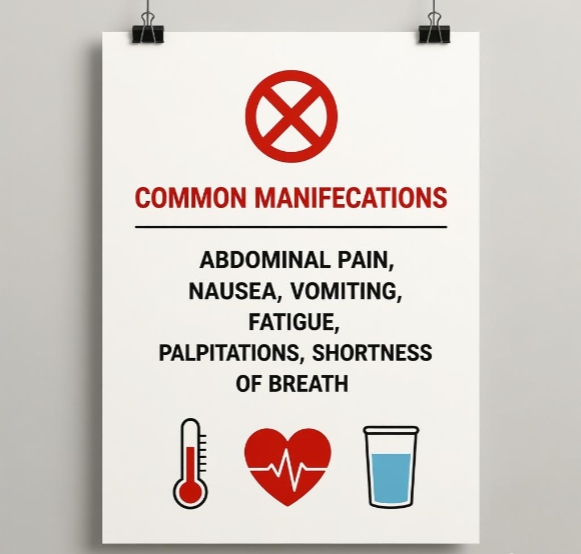Gastric bleeding is hemorrhage originating from the stomach wall. It may be microscopic, slowly oozing for days, or sudden and copious, endangering life within minutes. Because gastric acid quickly alters blood, the clinical picture can differ from bleeding at more distal sites; recognizing these nuances speeds resuscitation and endoscopic control.
- Key visual clues
• Coffee-ground vomitus: partially digested blood turns dark brown and granular; indicates low to moderate bleeding that has lingered in gastric acid.
• Fresh hematemesis: bright red or clotted blood expelled through the mouth signals brisk arterial bleeding, often >300 mL at once.
• Melena: black, tarry, sticky stool with a characteristic pungent odor; at least 50 mL of gastric blood typically needed to produce melena, which can persist for 2–3 days after bleeding ceases.
• Occult blood: no visible discoloration, but immunochemical stool test positive; suggests slow, chronic oozing often leading to iron-deficiency anemia. - Volume-related symptoms
• Postural dizziness or syncope on standing: ≥15 % circulating volume lost.
• Resting tachycardia >100 beats/min, orthostatic drop >20 mmHg systolic: early hypovolemia.
• Cold clammy skin, delayed capillary refill, hypotension <90 mmHg systolic: hemorrhagic shock (>30 % loss).
• Thirst, air-hunger, agitation: compensatory responses before measurable pressure falls. - Associated gastric features
• Epigastric pain or burning: may precede bleeding when ulcers or erosions are the source; pain sometimes lessens after blood buffers acid.
• Early satiety and nausea: common with diffuse erosive gastropathy.
• Non-bilious vomiting followed by sudden red blood: suggests Mallory-Weiss tear at the cardia initiated by forceful retching. - Contextual patterns
• Heavy NSAID or aspirin use: shallow erosions with slow ooze, little preceding pain.
• Alcohol binge or Helicobacter-associated ulcer: deep crater with visible vessel, higher risk of massive recurrence.
• Portal hypertension: gastric varices or portal hypertensive gastropathy—bleeding can be torrential yet painless.
• Stress-related gastritis in critical care: oozing from multiple petechiae, often discovered via nasogastric aspirate. - Red-flag combinations demanding urgent intervention
Syncope plus any hematemesis, continuous fresh blood via nasogastric tube, melena accompanied by systolic pressure <90 mmHg or heart rate >120 beats/min, and mental confusion with cool extremities.
Summary table
| Sign/Symptom | Typical volume | Immediate action |
|---|---|---|
| Coffee-ground vomitus | 100–300 mL | Urgent gastroscopy within 24 h |
| Fresh hematemesis with clots | >500 mL often | Large-bore IV, cross-match 4–6 units, ICU bed |
| Melena without shock | 50–200 mL | Monitor vitals every 30 min, Hb at 6 h intervals |
| Orthostatic drop | ≥15 % loss | Rapid crystalloid, set transfusion trigger Hb <70 g/L |
| Syncope, hypotension, tachypnea | ≥30 % loss | Activate massive transfusion protocol, secure airway |
